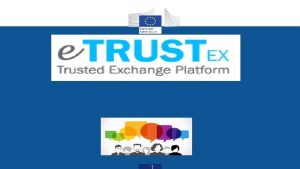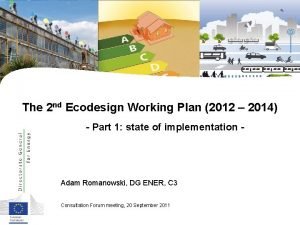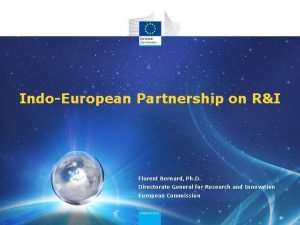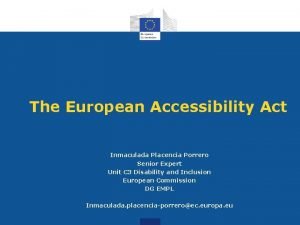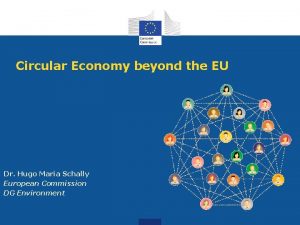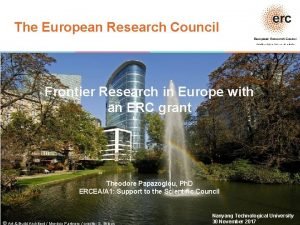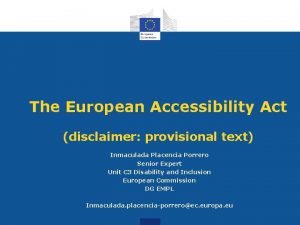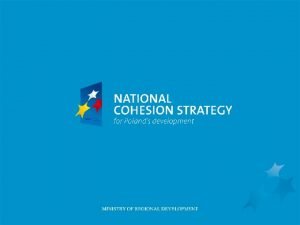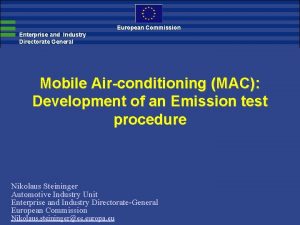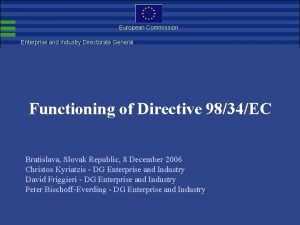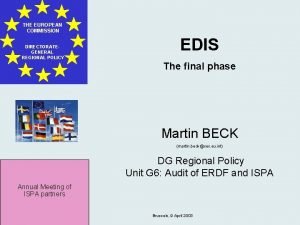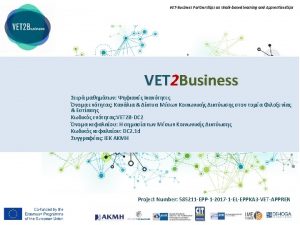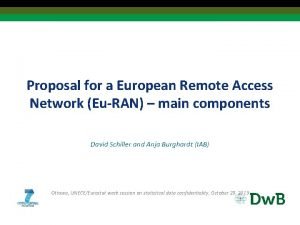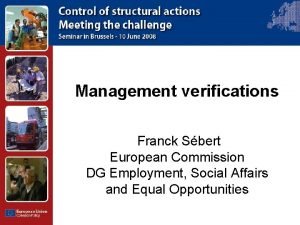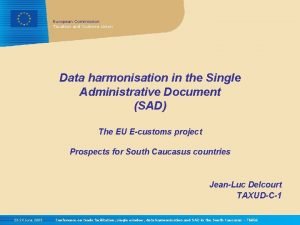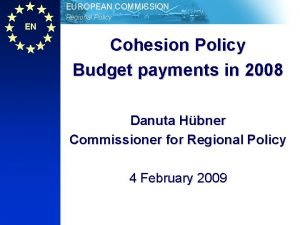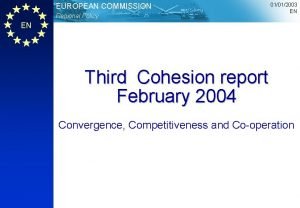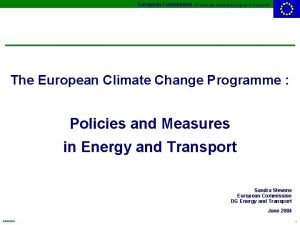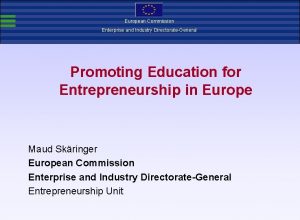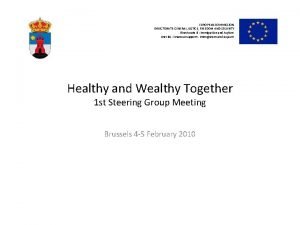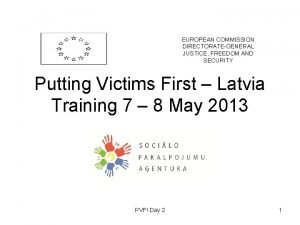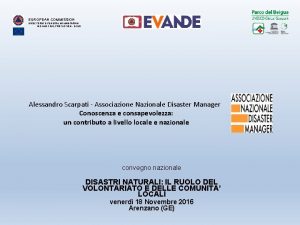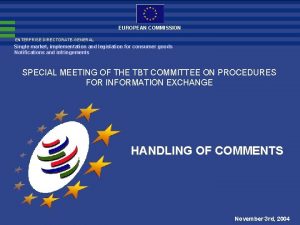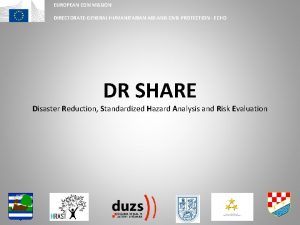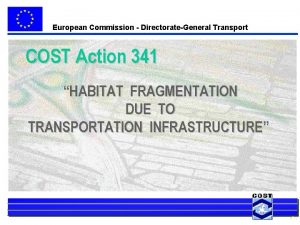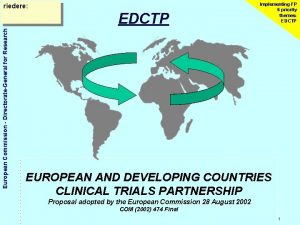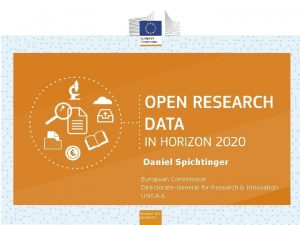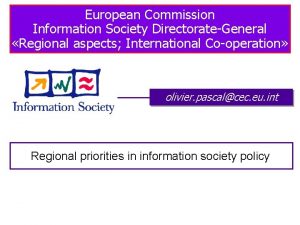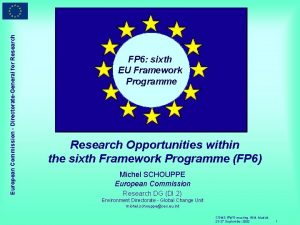EUROPEAN COMMISSION Education and Culture DG DirectorateGeneral Integration





























- Slides: 29

EUROPEAN COMMISSION Education and Culture DG Directorate-General Integration of students with migrant or minority background in mainstream education The Baltic case prepared by Liesma Ose, in cooperation with Eve Mägi and Hanna Siarowa

Content • Brief overview on education for ethnic minorities and migrants in The Baltics • Does education integrates or segregates? Criteria and indicators. • Current policies in Estonia, Lithuania, Latvia • Conclusions • Discussion and policy implications

Methodology for Criteria development • European Indicators for Immigrant integration. Migrant Policy Group, 2013. • Muizhnieks, N. (ed. ) How Integrated is Latvian Society? An Audit. 2010. • Cohler, C. , SIRIUS WP 1. Policy implementation analysis by national educational agents and other stakeholders. Comparative report. European Forum for Migration studies, Institute at the University of Bamberg, 2013. • Study on educational support for newly arrived migrant children by Public Policy and Management Institute. Publications Office of the European Union, 2013.

Overview: Estonia • Minority education system since 1990 s, still dual school system -Russian and Estonian schools. • Estonian language is being thought as a subject, or using bilingual education techniques, mainly submersion or recently introduced CLIL. • In 2011/12 26% of the total number of students were with miniority background. • Estonia has a relatively small number of new immigrant students (136 in 2009 , 171 in 2012/2013 ).

Overview: Lithuania • • In 2011/2012 - 1175 schools with Lithuanian as the main language, 55 schools – Polish language of instruction, 36 – with Russian, 1 – with Belarusian (1 Jew and 1 German) and 42 schools with different languages (mixed schools). 363 930 of students were accessing the education in Lithuanian (almost up to 93 %), 15552 of students – in Russian, 12895– in Polish and 181 students were in Belarusian school. Small population of foreign residents; majority from Russia, Belarus and Ukraine, small number of Chinese , Vietnamese, Korean, other nationalities. 70% of immigrant children attend ethnic minority or bilingual schools. • Major target groups that might need additional support: • immigrant students per se who are coming from both EU and third countries; • children belonging to national minorities; • returning immigrants – persons with Lithuanian citizenship or ethnic Lithuanians.

Overview: Latvia • Multiethnic composition of Latvia ( having ~ 41 % of non – Latvian population – Russians, Ukrainians, Poles etc. ) influenced the development of bilingual education ( 1999 in basic education; since 2004 in secondary education) in order to ensure knowledge of Latvian among all the ethnic groups. • The principal element that distinguishes the Latvian system is the provision of mother tongue instruction in 8 languages ( Russian, Ukrainian, Polish, Roma etc. ) both in primary and secondary (including upper secondary) schools with proportion of instruction 60% in Latvian, 40% in minority language. • Small number of migrant students: In 2012 there were 546 children from foreign background studying in Latvian schools out of which 140 children are from Russia, 26 from the USA, 10 from Thailand, 10 from Korea, and 2 from Venezuela and 1 from China.

Criteria for Migrant integration in mainstream education (based on Muizhnieks, 2010, MPG, 2013, NAMS, 2013) Equal rights in Education (nondiscrimination, recognition) Contact with majority representatives ( intercultural contacts) Participation, involvement, shared responsibility, influence on public affairs Is there any targeted measures for cultural adapt ation implemented? Is there any support measures for both official language learning and mother toungue of migrant students in force? What is the ethnic and social Do parents with migrant make-up of students at various background participate in levels of education? school affairs? Do mainstream and minority schools have any contact? To what extent do schools teach intercultural competence? Are minority/migrant NGO s, teachers’ professional networks involved in school work? Is quality of schools having minority and migrant students the same as in mainstream schools? Is quality early education and care ensured for migrant children? How serious a problem in schools is violence based on ethnicity, language or other grounds? Does consultative mechanisms, representing migrants and minorities, established and working in education policy exist?

Criteria +Indicators Equal rights in Education (nondiscrimination, recognition) Contact with majority representatives ( intercultural contacts) Participation, involvement, shared responsibility, influence on public affairs Targeted measures for cultural adaptation Existance and proportion of Parental involvement ethnicly mixed schools Support in official language Cooperation between learning mainstream and minority schools Teachers with minority/migrant background in schools Language support for mother tongue Consultative boards of migrant/minority stake holders at Mo. E Intercultural training /citizenship education for students Quality early education and Intercultural competencies care of teachers Quality education for all , regardless ethnic composition in school Mechanisms against bullying and ethnicity based violence in schools

Estonia. Equal rights in Education. Inclusion vs Segregation • Quality differencies between Russian ( where majority of migrant students are enrolled) and Estonian schools; • Estonian general education system enables to study in various languages; • Growing ability to support all students with various languages and migrant background. ; • Targeted measures: Different mother tongue from Estonian can be considered as an educational special need (The Basic Schools and Upper Secondary Schools Act of 1997).

Estonia. Equal rights in Education. Inclusion vs Segregation ( cont. ) • Intensive Estonian language learning support; • Individual guidance and customised exams in Estonian. • Assistant teachers, support services (e. g. school psychologist, social pedagogue ) on the ground of an extra funding for schools, having migrant students; • Common Estonian language kindergartens for all students (with special assistant teachers for children with other mother tongue ) is considered as the best early integration practice.

Estonia. Intercultural contacts. Could be better. . . • Ground for contacts: Etnically mixed kindergartens, schools. • Russian or Russian – Estonian bicultural students form ~ 26%. • Diversity, tolerance education in general curriculum, still issues with implementation due to unsufficient teacher training on intercultural competence. • Teacher training model does not include a systematic preparation for working with migrant students.

Estonia. Lack of representation =Lack in Participation • Small number of and scattered population/communities of migrants; • Schools have strategies on pupils’ integration; • Strategies of parental involvement are underdeveloped in connection of low awareness of interculturality among school staff; • Still there are minority education activists, some coping with mainstream policies, and some are opposing.

Lithuania. Equal rights in Education. Inclusion vs Segregation • Lithuania guarantees national minorities the right to have schooling in their native languages. • Immigrant children immediately integrated in mainstream schooling. • National minority schools receive extra 20% of funding for supporting minority and 30% for supporting immigrant students • Every child with legal residence status in Lithuania has right to attend state kindergarten. • Migrant children are mostly taught in mainstream schools, Russian and Polish speaking migrants in mainstream minority schools.

Lithuania. Equal rights in Education. Inclusion vs Segregation • Curriculum provides flexibility for meeting immigrant needs; • Individualized support in learning and cultural adaptation, assistant teachers, culturally sensitive counselling is being developed; • Mother tongue is taught in minority schools - although not each language is represented; • • Continuous instruction of Lithuanian as a second language up to 10 th grade included; • Integration class can be organised in every school if there are more than 5 migrants.

Lithuania. Intercultural contacts. Could be better. . . • No national level approach to diversity in school; • Monitoring and analysis of immigrant situation is underdeveloped; • Teachers are not always prepared to meet the needs of immigrant students; • No structured training in intercultural and bilingual teaching; • No universal teacher training for intercultural skills , still intercultural training for teachers on the local basis; • No incidences for discrimination against migrant students in school.

Lithuania. Developing representation enforces participation. • No migrant and foreign trained teachers in Lithuanian schools, only in minority schools, where • students are taught by teachers representing the same minority (mostly) in a bilingual way. • Developing partnerships between immigrant communities and schools; • Parental involvement on the local basis.

Latvia. Equal rights in Education? First steps made • Every school age child is entitled for free schooling; • Higher education is not free: 3 rd country nationals have to pay higher fees; • No consistent policy on education on migrants (because of rates of immigrants being low); • Schools are not prepared for students from other countries than Russian-speaking countries; • No extra funding for schools integrating migrant students --> extra time and resources cannot be covered;

Latvia. Equal rights in Education? First steps made ( cont. ) • Minority schools with bilingual education have same quality as mainstream schools; • Bilingual education models in minority schools, where majority of migrant pupils are enrolled, ensure both sufficient knowledge of official language , as well as mother toungue support ( 8 languages, but there is no support for Chinese, Farsi, Dari, Hindi, Arabic etc. ); • Good teaching aids, esp. for Latvian teaching with emphasis on cultural adaptation: still implementation is not sufficient.

Latvia. Intercultural contacts • No government policy in the field of diversity management in school • No disaggregated data collection on the ground of ethnicity and mobilitu, centralized data collection on SES and native language; • Intercultural training for teachers not part of a general policy, only in EU-funded projects. State and non state actors (NGO Education support center) offers in - service teachers variety of state recognized professional fulfillment courses on intercultural competence building • Since 1999, regular Cooperation between mainstream and minority schools;

Latvia. Intercultural contacts ( cont. ) • Intercultural training for teachers on the local basis. Projects enhancing intercultural competences for teachers: high rate of participation. • Need for Bilingual education and intercultural education: consistent and general approach, making teachers participate in in-service courses • Good teaching aids, esp. for Latvian teaching with emphasis on cultural adaptation: still implementation is not sufficient.

Latvia. Lack of representation = Lack in Participation • Information materials for parents about education system, official language learning; • Parental inclusion on local basis, by schools having representative number of migrant pupils ( big cities, Riga, Daugavpils); • No strong migrant education rights advocacy NGOs, some functions performed by public policy institute Providus; • On national level – Advisory Board on Third country nationals integration, with no decison making power.

Conclusions Equal rights? • Strict and ineffective immigration policies. • The lack of conceptual framework and transparent mechanisms in identification of target groups. • Common national curricula -multiple languages of instruction. • Bilingual education = bicultural or multicultural school routine. • Minority/migrant students’ needs sensitive policies in Estonia and Lithuania, lack of such in Latvia. • Targeted measures are rather scarce and incidental.

Conclusions Intercultural contact • Teacher training model (both pre - and in service) does not include a systematic preparation for working with migrant students. • Cooperation projects among schools with diverse languages of instruction on national and international ground are common practice.

Conclusions Participation • All three Baltic States in their education policies are aiming at parental involvement, school - community relationships, • but current lack of understanding of diversity and lack of tolerance among socially shared values, plus having deficit of culturally competent school staff • prevents from quality implementation of those policies.

Policy implications Equal opportunities • Improving data collection system, especially in Latvia • Targeted measures 1) Providing individual, state financed support; 2) Hiring specialized staff to support teachers in their work with migrant students; 3) Improving teacher’s preparation and knowledge to work with children that need additional language support.

Policy implications Intercultural contact Inclusion of intercultural education into curriculum; • To bring more multicultural component into both teacher pre- and in-service training which is convenient to achieve in cooperation with universities who provide teacher training; • To produce and guide the usage of various support materials related to migrant education; • Positioning of interculturalism as a necessary component of organizational culture of any education institution.

Policy implications Participation Operational strategies and vision for migrant education may be a role of local government • Increase in parental involvement: principle of shared responsibility with student’s parents

Selected bibliography • Estonia. Nestor, M. , Mägi, E. (2013). The National Focus Group Report: Estonia. Praxis Center for Policy Studies, Tallinn, Estonia. • Mägi, E. , Nestor, M. Students with different mother tongue and cultural backgrounds in Estonian schools: attention, awareness and support at school level, Praxis Center for Policy Studies, 2014. • Lithuania. Siarova Hanna. SIRIUS WP 1 – Country review policy implementation analysis/Lithuania, 2012, Public Policy and Management institute • Latvia. Osis, J. National Round Table report, SIRIUS, Global Development Institute, 2013. • M. Golubeva, Education Reforms and Access to Education: Reform Monitoring Report (in Latvian) Izglītības reformas un izglītības pieejamība. http: //politika. lv/article/izglitibas-reformas-un-izglitibas-pieejamiba

Thank you for attention! For questions and comments: Liesma. Ose@gmail. com
 Mudaliar commission is known as
Mudaliar commission is known as What is graduated commission
What is graduated commission Trainee european commission
Trainee european commission Etrustex
Etrustex European commission
European commission Brendan devlin european commission
Brendan devlin european commission Adam romanowski european commission
Adam romanowski european commission Anic tschumi
Anic tschumi Inmaculada placencia porrero
Inmaculada placencia porrero European commission sustainable finance
European commission sustainable finance European commission
European commission Hugo maria schally european commission
Hugo maria schally european commission European commission
European commission Inmaculada placencia porrero european commission
Inmaculada placencia porrero european commission Cost benefit analysis european commission
Cost benefit analysis european commission European commission
European commission European commission
European commission European commission
European commission European commission
European commission Hilton
Hilton Remote access european commission
Remote access european commission Franck sebert european commission
Franck sebert european commission European commission taxation
European commission taxation European commission
European commission 01012003
01012003 Wolfgang philipp
Wolfgang philipp Eureka eurostars eligibility
Eureka eurostars eligibility Innovation procurement european commission
Innovation procurement european commission Dg transport european commission
Dg transport european commission European commission community research
European commission community research



